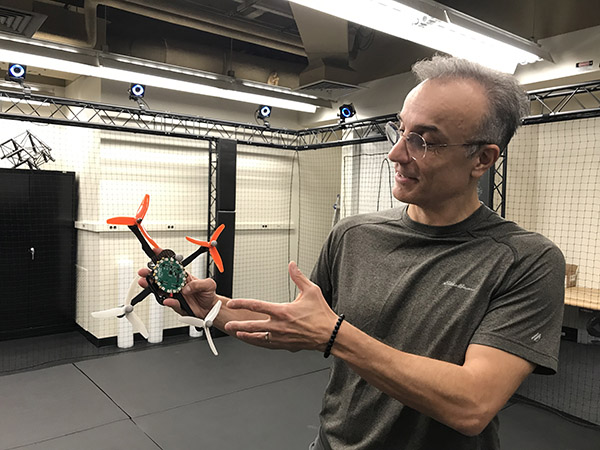Amy Sprague
November 25, 2019
The missions to Mars incorporated complexities that are consistent with what autonomous vehicles would have to navigate on Earth in especially challenging and critical tasks. – A&A professor Behçet Açıkmeşe

Professor Behçet Açıkmeşe with an experimental quad rotor in the Autonomous Control Lab.
A research team spanning three universities led by A&A professor Behçet Açıkmeşe received a total of $1.2 million from the National Science Foundation to leverage insights from autonomous missions to Mars to advance humanitarian applications here on Earth.
The UW, Stanford, and Johns Hopkins will collaborate, each bringing special expertise to the partnership. Açıkmeşe leads A&A’s Autonomous Control Lab and previously worked at NASA’s Jet Propulsion Lab where he developed guidance and control algorithms for the Curiosity rover landing in 2012. This experience put him in a unique position to apply insights from Mars missions to advancing autonomous control algorithms for challenging cases. At Stanford, professor Marco Pavone also worked on Mars missions with JPL, but with ground missions. At Johns Hopkins University, professor Marin Kobilarov brings his expertise with underwater autonomous vehicles to the partnership.
The project’s focus will be critical autonomous missions that have the potential to remove humans from harm in traditionally dangerous tasks. Applications include search and rescue, disaster relief, environmental monitoring and toxic spill clean-up.

The Autonomous Control Lab's research includes this fleet of ground robots used to validate control algorithms for robotic swarms.
Says Açıkmeşe, “The missions to Mars incorporated complexities that are consistent with what autonomous vehicles would have to navigate on Earth in especially challenging and critical tasks. These complexities include switching between a variety of operational modes; limited fuel, power and time; environmental constraints and situational awareness. Our project will provide algorithmic foundations to maximize mission outcomes via novel planning and control algorithms, while meeting these and other challenges.”
The project will execute both a theoretical and an experimental component. In addition, the researchers plan to consult with practitioners in the field who could use improved autonomous vehicles such as firefighters and disaster responders. The research team also has Miguel San Martin of JPL (chief guidance and control engineer) as a project advisor. The algorithms produced will be tested at the three participating universities with quad rotor drones and underwater autonomous vehicles.
A&A Chair Kristi Morgansen noted, “What is especially noteworthy about this grant is that it will advance the field of autonomy by tackling critical human challenges and deliver a rich theoretical and experimental experience for our students.”